Do you live in South Carolina where you often come across tiny green frogs during the summertime? Have you ever wondered about the origin and heritage of these frogs?
Well, you’d be surprised to learn about the various different types of frogs you can find in South Carolina. First of all, there’s the northern and southern cricket frog. There’s also Cope’s gray tree frog, which you should not mix up with the regular gray tree frog. There are also some rare frogs, like the bird voiced tree frog or the ornate chorus frog.
These are just a few names; there are plenty more varieties available in South Carolina.
Read on to find out more about the different types of tree frogs found in South Carolina. If you’re a curious frogger and want to catch one or two of these gremlins, learning about them will really help you out. So why not scroll down a bit right now?
Where do tree frogs in South Carolina live?
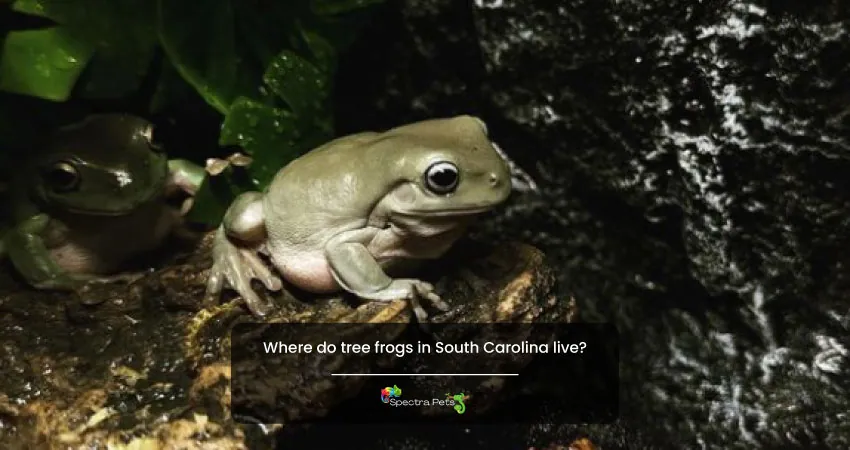
There are numerous species of tree frog in South Carolina thanks to the natural habitats there and the humid subtropical climate. Some of the species in this area are native, while others are exotic.
Frogs are typically found near freshwater sources and vegetation. The reasoning behind this is that they cannot survive in habitats that are near saltwater. These anurans inhabit places like marshes and ponds. Lakes and freshwater streams are also among the probable locations where you can easily find them. You would be surprised to know that they inhabit forests and swamps as well.
These creatures are amphibians, which means they are adept at living on land just as well as underwater. They all prefer different types of water bodies to live in, and some have mastered living on trees.
The typical habitat of tree frogs is densely forested areas with trees. Despite their name, they are frequently found close to both permanent and transient water bodies.
Maybe you are interested in learning more about frog species as an enthusiast? I got you covered. In this article, I’ll try to make you familiar with tree frogs that are native to South Carolina.
Read Also: Rarest Frogs in The World
How do I identify tree frogs in South Carolina?
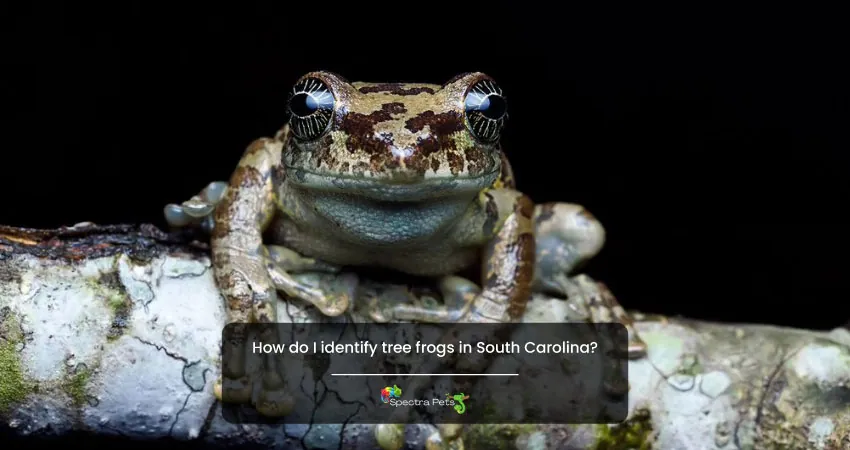
There are so many tree frogs in south carolina that it’s easy to get confused between them. In the past, it happened to me as well. But, what I realized was, it’s easier to identify them if you know
The following are descriptions of each of South Carolina’s 16 tree frog species. This article also includes information about their scientific names, life spans, sizes, physical characteristics, routines, and interactions with predators.
These frogs, unless otherwise noted, are pretty commonly found in the region and are not on any lists of endangered species.
1. Northern Cricket Frog
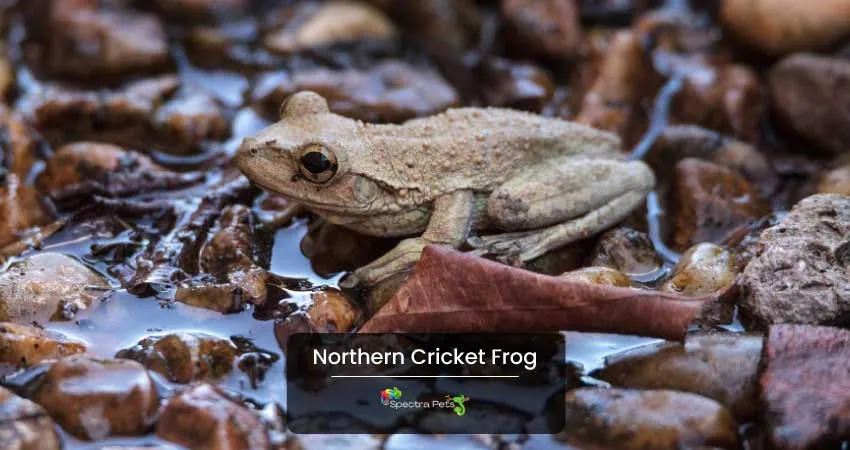
- Family: Hylidae
- Scientific Name: Acris crepitans
- Size: 1.3 to 3.6 cm
- Lifespan: up to 4 months as wild, with maximum lifespan of 5 years under captive care
The northern cricket frog is a species that shows a rare behavior among tree frogs; it doesn’t usually inhabit trees. In North Carolina, these frogs are a pretty common sight. You can also see them in abundance in Canada and Mexico as well.
These small amphibians have warty skin and are tiny. Their eyes are divided into a triangle, and they have webbed toes with small wrists. Despite having well built hind legs, they are not skilled climbers.
The body hue of this frog can vary in color. There is a mid-dorsal stripe on most of their backs that ranges in color from orange to brown.
This species of frog has a line that extends from each eye to each forelimb. On the thighs, they have dark bands or stripes.
As diurnal creatures, these frogs are more active during sunlight. The northern cricket frog’s call resembles the rapid clicking of two stones. They favor living close to wide, shallow water.
This species of frog consumes insects. Freshwater fishes and snakes are their worst enemies as they like to frequently prey upon them.
Northern cricket frogs jump strongly and zig zag to escape predators because they are unable to live in trees.
2. Southern Cricket Frog
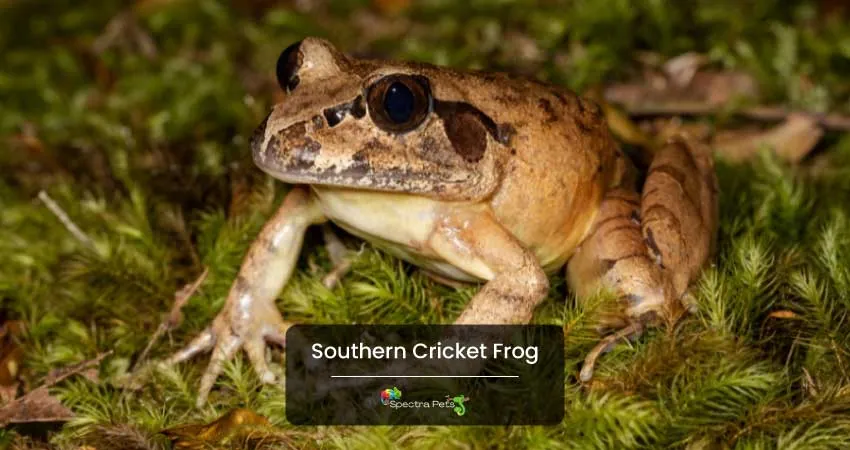
- Family: Hylidae
- Scientific Name: Acris gryllus
- Size: 1.2 to 3.3 cm
- Lifespan: usually 4 months
As the name suggests, these frogs inhabit the south-eastern region of the United States.
These frogs enjoy living in temperate climates and like to live on the earth near sunny freshwater. They prefer moist bushes but do not prefer to climb trees.
Cricket frogs in the south resemble those in the north. These amphibians are tiny, and the middle of their backs are covered in stripes, which are typically orange, although sometimes you’ll spot them in brown. They come in shades of black, brown, gray, and olive green.
Unlike their northern counterparts, southern cricket frogs lack sufficient muscles in their toes for climbing. This species has a pattern on their thighs that is quite dark, and a triangular marking on their head. This striped pattern is surrounded by a lighter-colored stripe and has linear edges.
The tree frogs in the north and south are distinct from one another. The snouts of these amphibians are more pointed, and their warts are less obvious. Even their toes aren’t webbed that much. These frogs are also smaller and more slender. They can jump more than twice as high as the northern variant.
Their call also resembles the clicking of two marbles. The Northern variation has faster clicking noises, though.
Southern Cricket Frogs are insectivores. Fish, birds, and even lizards are their predators. They leap swiftly out of the way of these attackers. In order to blend into their surroundings, they also cryptically change color.
3. Bird-voiced Tree Frog
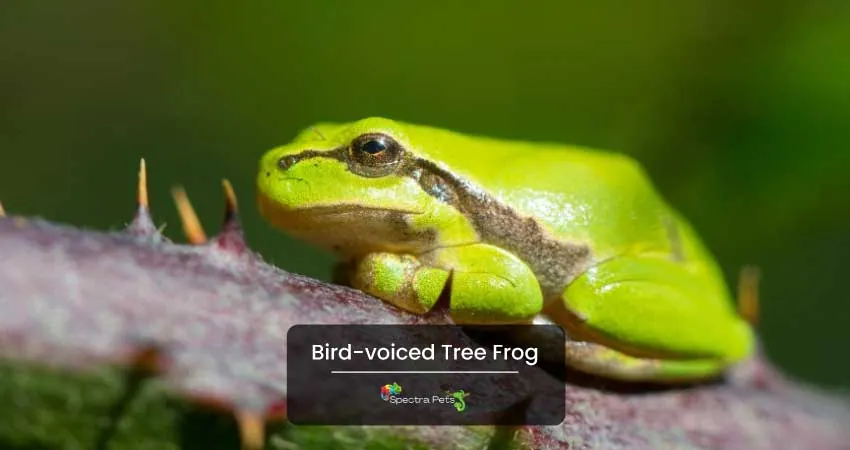
- Family: Hylidae or
- Scientific Name: Hyla avivoca
- Size: 2.8 to 5.2 cm
- Lifespan: usually 2 years, about 4 years in as a pet
Bird-voiced tree frogs are unique residents of the U.S.
While rare in Illinois, these frogs are common in the neighboring states of Alabama, Tennessee, and even Georgia. They occupy trees that are located above water.
Bird-voiced tree frogs typically have smooth backs that have many different colors, such as gray, black, brown, or even green. They have white spots beneath their eyes, and they have rounded snouts, webbed and cushioned toes, and dark blotches on their backs.
The limbs of these frogs are colored gray or lime green, and they have dark stripes on them. There are dark spots on their white bellies. Females tend to have a larger appearance than males.
A bird-voiced treefrog’s call resembles the chirping of birds, as its name would imply. This frog leads a solitary life until it’s time for breeding. They are nocturnal by nature.
These frogs consume both insects and other arthropods besides insects. Various snake and bird species are predators of bird-voiced tree frogs. Because of their ability to blend in with their surroundings and their coloration, predators are less likely to notice them.
4. Cope’s Gray Tree Frog
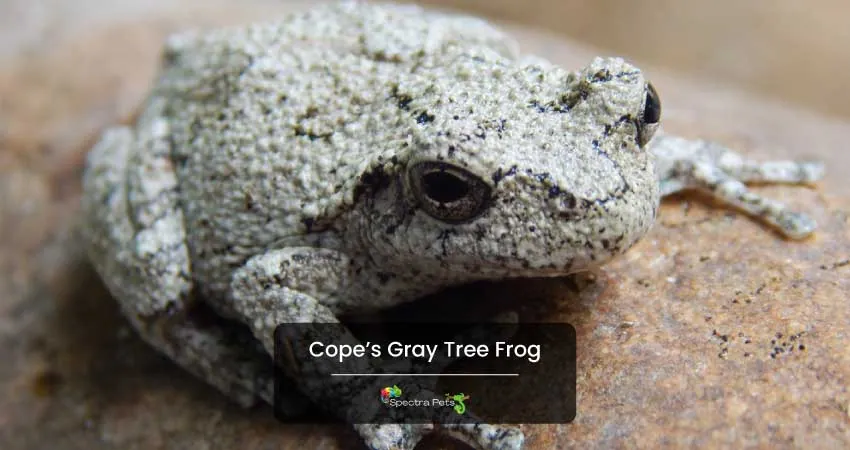
- Family: Hylidae
- Scientific Name: Hyla chrysoscelis
- Size: 3.2 to 6 cm
- Lifespan: 2.5 to 7 years
The Cope’s Gray Tree Frog is a species that is profoundly found in Northern America.
These frogs can be found in Ontario, as well as in the states of South Carolina, Florida, and even Texas. They live close to both transient and ongoing water bodies.
The Cope’s gray treefrog has no noticeable physical distinctions between the sexes. Although their skin is warty, the skin texture is not very rough, unlike that of a typical toad.
With toes that have an adhesive nature, these frogs are biologically prepared to live in trees. There are white marks under their eyes, as well as black specks on their upper torso.
Gray is the most profound color of these frogs. Seasons, humidity, and substrate all have an impact on this color. There are also frogs that are green, gray, and brown, among other colors.
These frogs live alone and are nocturnal. Other than during the reproductive season, they hardly come to the ground. This treefrog’s call is quick and high-pitched, like a vibrato.
Cope’s gray tree frogs consume smaller frogs, other invertebrates, insects, and larvae. They are consumed by frogs that are bigger in size, different bird species, enormous water bugs, small mammals, and freshwater snakes.
In order to escape from predators, these frogs live in high trees and have a decent skill at camouflaging themselves. These frogs have the ability to alter their color, so they can hide by adapting to the color of their surroundings and avoiding being seen.
5. Green Tree Frog
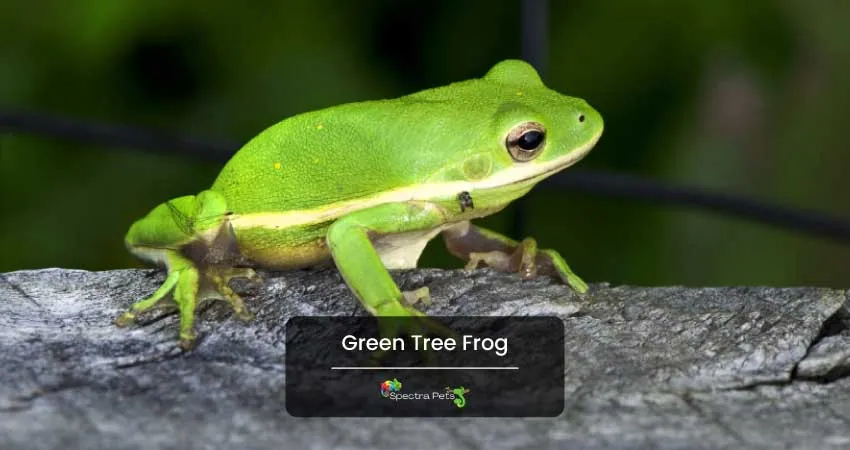
- Family: Hylidae
- Scientific Name: Hyla cinerea
- Size: 3.2 to 6.4 cm
- Lifespan: about 6 years
The Green Tree Frog is a very beloved species of tree frog amongst pet enthusiasts due to its vivid and striking color. It is mainly present in the southeastern US states, as well as in the central states. This frog prefers environments with open canopies and a lot of floating plants.
These frogs have smooth skin, long legs, and large toe pads. There are two tubercles that are heavily webbed on their rear limbs. The females of these frogs are larger than the males.
The majority of green tree frogs are a vivid yellow-green hue. Other dorsal hues exist, ranging from reddish-brown to green. It’s common to see golden spots covering the body color.
Typically, their underbelly is creamy white. A noticeable line that is also creamy white is present on each side of their dorsum.
These frogs spend most of their time alone and are lively in damp or humid conditions.
These amphibians use various distinct calls to communicate. There are three calls: an alarm call to warn others of incoming predators; a mating call; and another to indicate rain.
They eat mostly small, moving insects. Larger frogs, snakes, avians and different large fish are some examples of predators. They tuck their legs in, close their eyes, and hide in the vegetation to ward off predators.
6. Pine Wood’s Tree Frog
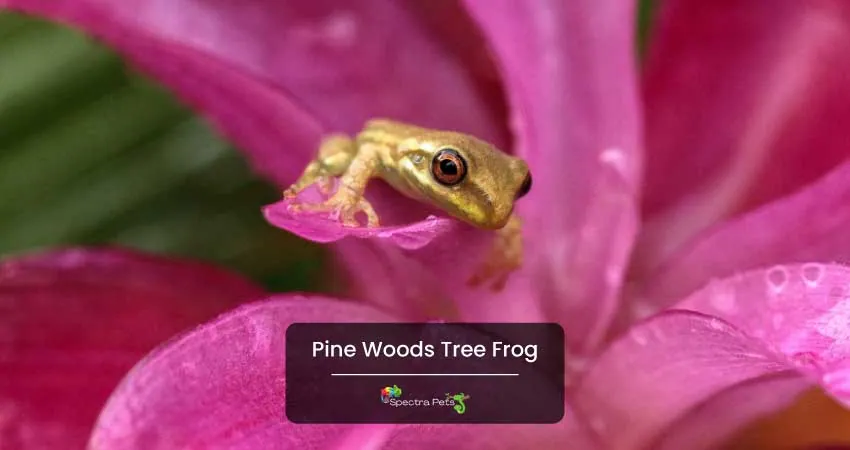
- Family: Hylidae
- Scientific Name: Dryophytes femoralis
- Size: 4cm
- Lifespan: about 8 years in captivity
The Pine Woods Tree Frogs are found everywhere in the southeastern U.S. This implies that they are native to and unique to this area. These frogs frequently reproduce in transient wetlands like ditches along roads.
This species resembles a different species of treefrog known as the squirrel tree frog. They can be distinguished by a series of spots on the inner thighs that are hidden when they rest.
The Pine Woods Tree Frogs are medium in size. Females are usually larger than males. Their bodies are narrow, and their toes are slightly webbed. They usually have skin that is gray, dull green, or brown in color.
There are sporadic darker pigment splotches scattered along their backs. They have spots on their side bellies that are yellow-orange. A frog’s appearance can vary depending on temperature and stress levels.
These frogs’ calls have a chattery, sporadic quality similar to Morse code’s brief sounds. Other than during reproduction, they live alone.
Outside of the procreating season, they reside in trees, and during the hot months they dig underground. These amphibians do not go into hibernation completely in the cold.
As crepuscular creatures, these creatures are most lively at dawn and dusk. To avoid predators, pine-wood tree frogs hop and jump. In addition to using camouflage to evade predators, they also make loud noises that startle any potential captors.
Terrestrial arthropods are a common prey. Freshwater snakes, rat snakes, ribbon snakes, fish, and raccoons are some of the typical predators.
7. Barking Tree Frog
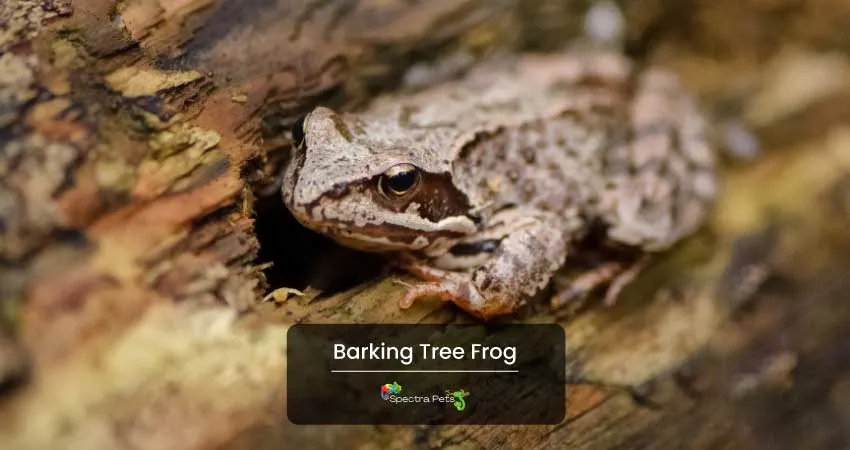
- Family: Hylidae
- Scientific Name: Hyla gratiosa
- Size: 5 cm to 7.2 cm
- Lifespan: 7 years in wild, 12 years as a pet
Barking tree frogs are able to live in water as well as on the surface. Their location depends on the weather; in humid weather, you can find them high in trees, while in a drought, you can find them underground. These are the biggest frog species that are currently recognized in the southeast U.S.
Typically, these frogs have green, brown, or gray backs with dark, rounded spots. Their skin tone could change, and the spot could gradually lighten in color as well.
The barking treefrog has a yellow line on both sides of its body. In order to climb trees, there are thick adhesive pads on their toes. The skin has a rough texture. If you hear a call that has about 10 syllables and sounds like a dog barking, a frog of this species is probably calling. They are nocturnal, solitary frogs.
This species of frog is an opportunistic and greedy feeder, consuming a variety of crickets and arboreal insects. Larger animals love to prey upon them.
These amphibians have the ability to quickly identify movement in order to run away from predators. Their anti-predator defenses include their keen sense of vision and color adaptation.
8. Squirrel Tree Frog
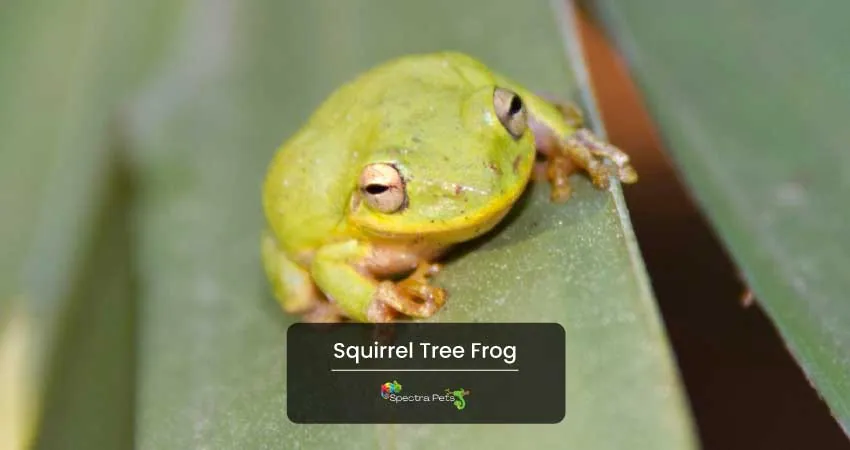
- Family: Hylidae
- Scientific Name: Hyla squirella
- Size: 2 cm to 4 cm
- Lifespan: about 8 years under captive care
In the US, the southern region is home to squirrel treefrogs. They are almost always found where there is moisture, shelter, and food.
Depending on the environment and temperature, these tiny frogs can range in color from brown to green. Their skins might have patterns or just be one color.
It might be necessary to eliminate other tree frogs with more consistent dorsal pattern traits in order to identify a squirrel frog. There is no physical distinction between a male and a female.
Although they are nocturnal, they can also be seen when there is humidity in the air during the day. These frogs can change their color, and when rain is on the way, you can hear them calling.
They primarily prey on tiny insects, but they also fall victim to larger species of frogs, snakes, and birds. To avoid being noticed by predators, these frogs use cryptic coloration.
9. Pine Barrens Tree Frog
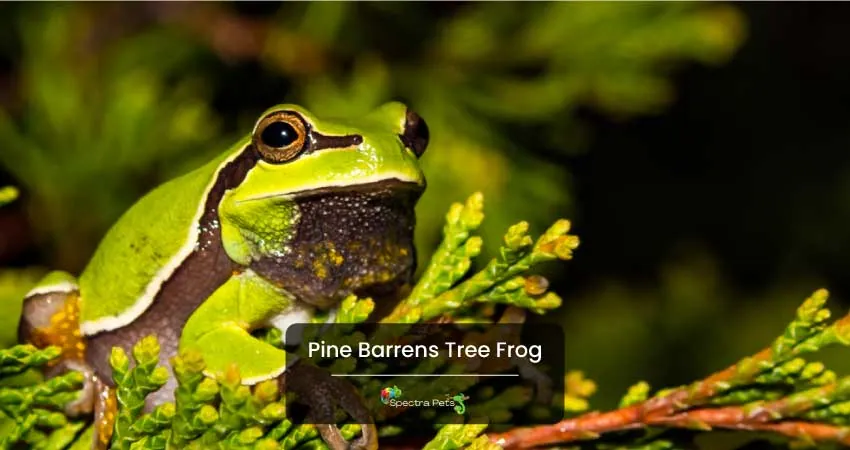
- Family: Hylidae
- Scientific Name: Hyla andersonii
- Size: 3 cm to 4.7 cm
- Lifespan: 2 to 5 years
Due to habitat loss, the Pine Barrens Tree Frog is a species of frog that is almost threatened in the state of South Carolina. The area includes New Jersey, South Carolina, and occasionally even Florida and Alabama.
Throughout the warmer seasons, these frogs reside in pools. However, once those dry out, these amphibians relocate to the moist soil that can be found in the underbrush. Despite being “tree frogs”, they spend the majority of their time on land.
The size of Pine Barrens Tree Frogs varies. Males are typically bigger than females.
These frogs make a quick, nasal call that is repeated roughly 20 times in a span of just 20 seconds. This is a unique trait of the amphibians belonging to the class Anura.
They have stripes of lavender on their sides and have a bright green hue. Often, white lines surround these stripes. On the interior of their rear legs, there are concealed orange patches.
The underside of these frogs is white. Sticky pads on each finger enable them to climb. The females’ mouth edges are white, and they have darker green patches on their throats.
Since there are not many predators, these amphibians are not agile by nature. They rest the majority of the time in the forest undergrowth. These creatures do, however, have a predatory nature and will eat things like beetles, flies, snails, slugs, grasshoppers, moths, and crickets.
10. Mountain Chorus Frog
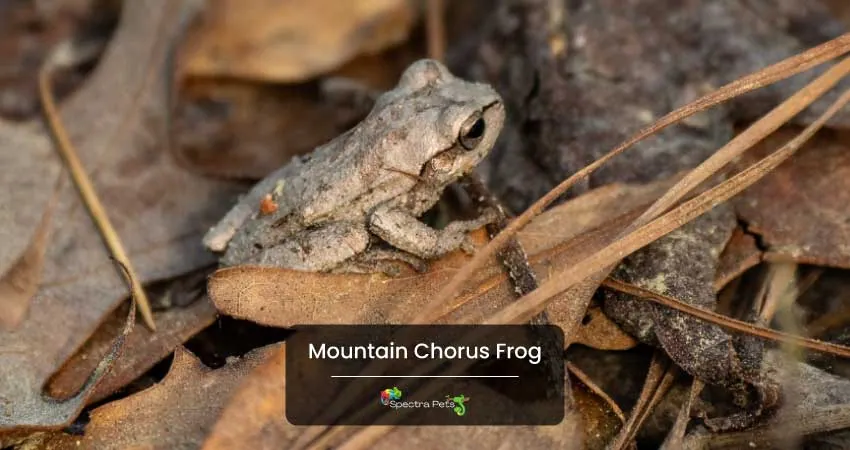
- Family: Hylidae
- Scientific Name: Pseudacris brachyphona
- Size: 2.5 cm to 3.8 cm
- Lifespan: usually 5 years, 7 years in captivity
Two distinct populations of Mountain Chorus frogs can be found in central, as well as northern Alabama. They are also profoundly seen in the Appalachian Mountains.
In areas with a lot of trees, mountain chorus frogs can frequently be found. They favor pools that are not very deep for breeding. Most of these frogs reside at elevations up to 1 km.
They can be in colors of gray and green on the dorsum. Their backs are covered in spots that range in color from light to dark brown. Age can also affect their color. While females have white throats, males’ throats can have any color, ranging from yellow to black.
Typically, they have a stripe from their eyes to their back. Their backs are marked with what looks like reverse parentheses. There is an X mark usually seen on their back.
This species of frog’s eyes have a black triangle between them. Its upper lip has a linear stripe that is white in color, just like the majority of chorus frogs. You can see yellow flashes under their limbs.
The mating season is the only time these frogs interact and communicate with one another. You can describe their call as a series of quick, slightly shrill twitters.
These frogs primarily consume insects, such as centipedes, grasshoppers, ants, beetles, bugs, spiders, and moth and butterfly larvae. Predators include larger frogs and snakes.
These amphibians have subtly adjusted to their surroundings. Because of the way their body color contrasts with the surrounding foliage, they are less noticeable to predators.
11. Brimley’s Chorus Frog
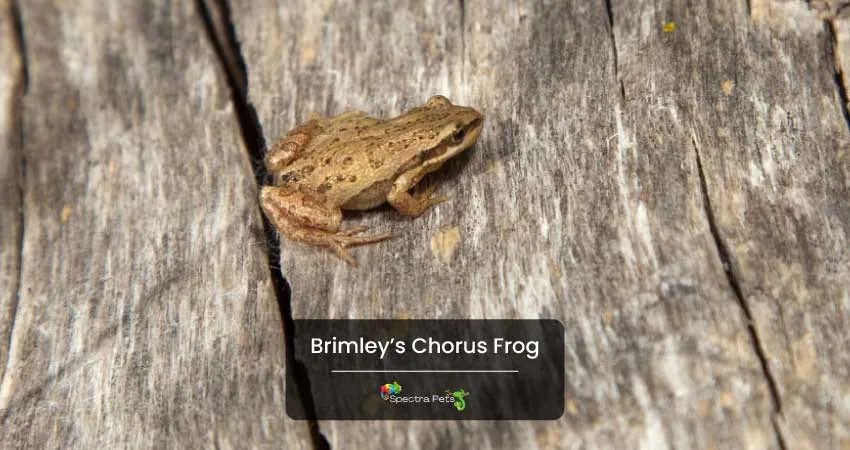
- Family: Hylidae
- Scientific Name: Pseudacris brimleyi
- Size: 2.5 cm to 3.3 cm
- Lifespan: 1 to 3 years
- The coastal plain of the Atlantic is home to Brimley’s chorus frogs. They only reside in the U.S., specifically in the states of North Carolina,Georgia, South Carolina, and Virginia. There are also a few discovered far from bodies of water, in pine forests,as well as grass fields.
These anurans primarily inhabit freshwater sources that are not very deep. They don’t migrate prior to or following breeding.
Typically, their backs have a light brown color with three darker lines in the middle. The exterior of the legs has a few dark spots. The color of their bellies is a yellowish white.
They have a stripe that extends from the nostril, going over the eyes and all the way to the crotch. These stripes might be either black or brown in hue.
The Brimley’s chorus frogs spend the majority of the night active. They are primarily eaten by arthropods and snakes.
12. Spring Peeper
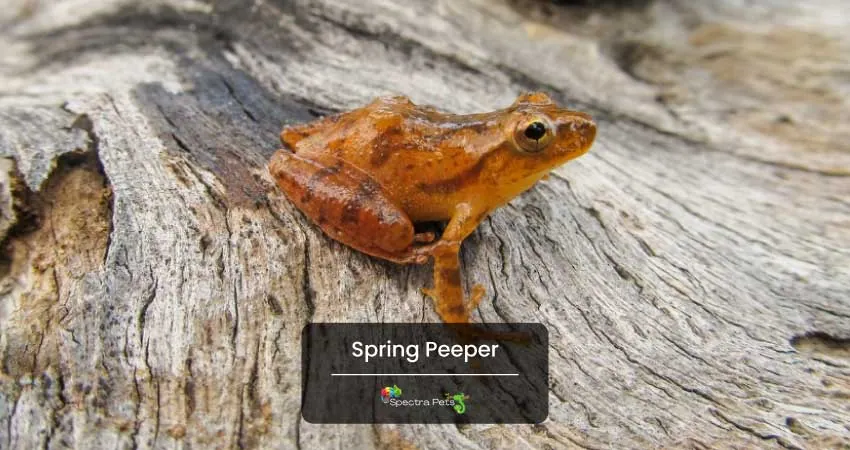
- Family: Hylidae
- Scientific Name: Pseudacris crucifer
- Size: 1.9 cm to 3.5 cm
- Lifespan: 0 to 3 years
Spring peepers are a species of chorus frog and one of the first to reappear after the winter. Their mating call typically marks the beginning of spring.
These frogs prefer wet areas around fields, grassy plains, ponds, and wetlands. During hibernation, you can also spot them in muddy areas. After the procreating season, it might be challenging to spot a wild one.
Common dorsal colors for this species of treefrog are gray, green, or brown. This frog has an X-shaped back and brown spots on it that are frequently erratic. There are dark markings on the limbs, and the belly has a white color.
They have toe pads that are not very big and moderate webbing on their feet that is suitable for climbing. The differences between males and females are not immediately obvious. Although it prefers to be on land where there are a lot of plants and leaves, it mostly lives in trees.
Their name comes from the peeping calls of these frogs, which herald the arrival of spring. The majority of this species of frogs lead a nocturnal life and are solitary.
These frogs consume other arthropods as well as insects. These frogs are preyed upon by numerous predators such as salamanders, birds, owls, and spiders.They use cryptic coloring, leap away from predators, and hide under mud or sink in deep water to avoid attack.
13. Upland Chorus Frogs
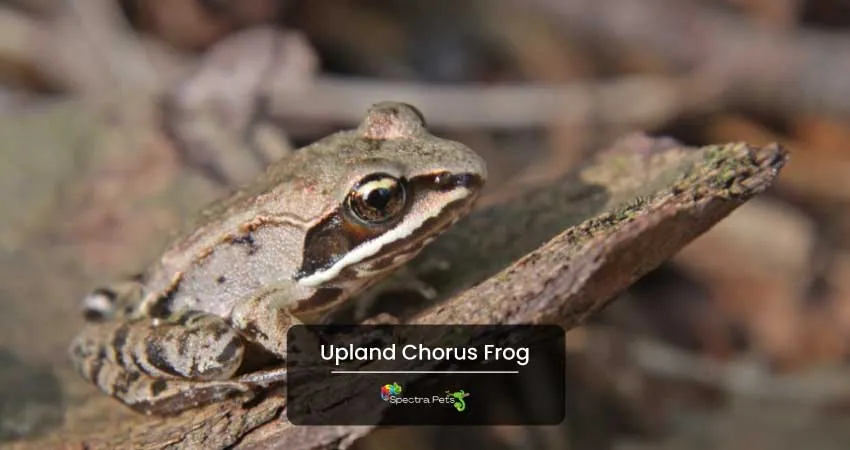
- Family: Hylidae
- Scientific Name: Pseudacris feriarum
- Size: 1.9 cm to 3.5 cm
- Lifespan: 1 to 5 years
The Upland Chorus Frogs are usually seen in the eastern United States. They live exclusively in the US. Several individual frogs have been found in the coastal plain of South Carolina.
These frogs prefer marshes and meadows, as well as forests as their natural habitat. They can also be found in bogs, grassy areas, wetlands, and wooded areas.
The upland chorus frog is a tiny creature. Typically, their body color is gray or brown. The back’s markings vary greatly, and the dorsum looks streaked or spotted. The top lip has a faint line running across it. Additionally, there is a dark linear mark that extends from the back to the eye.
The majority of these frogs have three straight lines on their backs, though these lines can be interrupted or even missing.
Physically, males and females are different. Under their chin, you will spot a vocal sac that is missing in females.
These frogs’ calls have been compared to the noise made when rubbing a finger across a comb’s bristles. This sound is smooth and quick.
The Upland Chorus Frog is a nocturnal creature that primarily consumes invertebrates. Snakes, turtles, racoons, fish, birds, and mammals are among the creatures that prey upon this frog.
14. Southern Chorus Frog
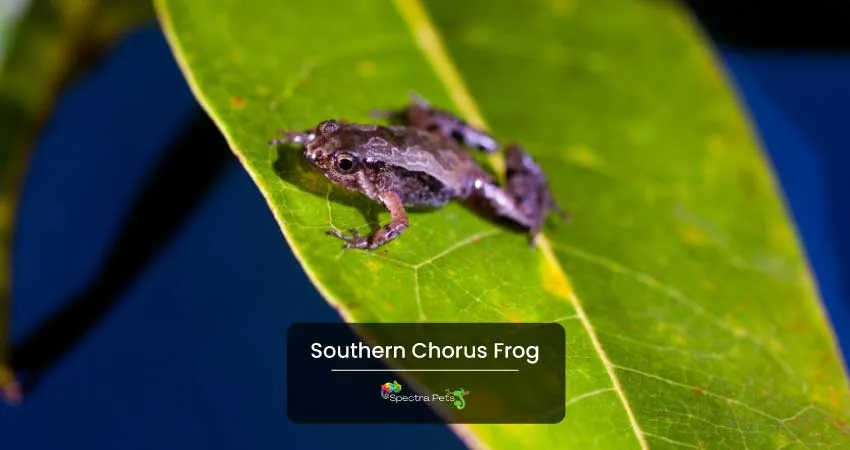
- Family: Hylidae
- Scientific Name: Pseudacris nigrita
- Size: 2.1 cm to 3.3 cm
- Lifespan: up to 3 years
In the U.S, the southern part is known to be home to southern chorus frogs. These frogs can be found in Florida, South Carolina, North Carolina, Alabama, Mississippi, and Virginia.
These frogs inhabit sandy soil, pine forests, and the vicinity of limestone sinkholes. A great place to find them is in the marshes. Ponds are also a great choice. So are rivers and the banks of rivers and streams in the prairies. These amphibians use both transient and stationary bodies of water.
The three lines on their skin are typically brown or gray. Although they occasionally have bumps on their bodies, they are generally smooth.
There are darker colored bands in the eyes. These frogs sport a white stripe around their lips, just like other chorus frogs do. The hue on their necks and their general size can help distinguish males from females.
Unlike female frogs, which typically have brighter colors like white, males have orange colored throats. Males of this species of frog are smaller in size than females, despite the fact that they are both typically small in size.
During the procreating season, these nocturnal frogs prefer living in groups. To avoid predators, they reproduce during the night and conceal themselves in long grass. Their vocalizations can be explained as a leisurely chirp.
They are primarily insectivorous, though their exact habitats have not been thoroughly investigated. These frogs are preyed upon by numerous birds and snake species.
15. Little Grass Frog
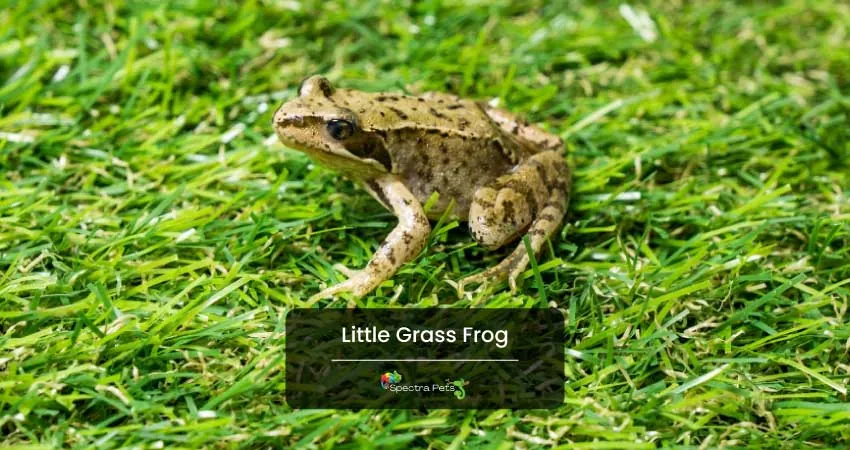
- Family: Hylidae
- Scientific Name: Pseudacris ocularis
- Size: 1.1 cm to 2 cm
- Lifespan: 5 to 10 years
Little Gray Frogs are tiny in size, as their species name suggests. These anurans the tiniest frog species found on the northside of America. Given their size, they are confined to smaller bushes.
Little grass frogs reproduce in grassy, shallow marshes. Roadside ditches, ponds, and dried pools are examples of their temporary locations.
This frog’s distinctive features include a pointy head and a dark, thick stripe that extends from the eyes down the back. They have very little webbing on their digits.
This frog typically has a reddish or brownish ground color. Sometimes you can see a dark line down its back. Its white or yellowish belly is visible underneath.
Some regions see year-round activity from them, with the exception of a brief hiatus during the colder months. Compared to females, males usually appear a bit smaller.
These anurans feed on a variety of different insects and spiders. Foraging on the ground is how they typically find their prey.
Invertebrates and vertebrates of various kinds are predators. They have cryptically colored bodies and jump great lengths to avoid these predators.
16. Ornate Chorus Frog
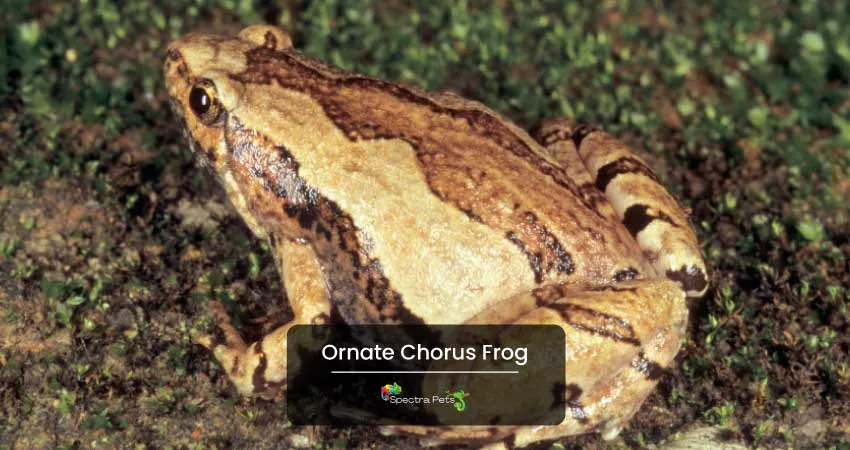
- Family: Hylidae
- Scientific Name: Pseudacris ornata
- Size: 2.5 cm to 3.2 cm
- Lifespan: 1 to 3.5 years
The Ornate chorus frog is found in marshes, forests, and open spaces with grasses like prairies. Outside of their breeding season, their elusiveness makes them hard to find. Small, sporadic water sources are where these amphibians breed.
These frogs are extremely vibrant. They frequently have hues of gray, brown, dark red, and even green. These frogs occasionally have yellow markings on the inner parts of their limbs and in their crotches.
A black straight line that resembles a mask runs across each of their eyes. The sides and crotches are marked with dark spots. Their toes have tiny, rounded tips.
These frogs prefer humid weather and are nocturnal. Their calls can be described as a series of sharp “tinks” that are frequently repeated. They consume small arthropods and insects because of their insectivorous nature.
They are preyed upon by birds, tiny mammals, and most snakes like the majority of anurans.
They use a variety of strategies to avoid predators. They leap far away in order to escape from predators with their strong jumps. Additionally, they bury themselves underground far from predators and lay flat when startled.
FAQ (Frequently asked Questions)
What are small tree frogs in South Carolina?
Small frog species found in South Carolina include northern cricket frogs, southern cricket frogs, squirrel tree frogs, mountain chorus frogs, Brimley’s chorus frogs, spring peepers, upland chorus frogs, little grass frogs, and ornate chorus frogs.
Are there poisonous tree frogs in South Carolina?
Luckily, there have been no reports of poisonous tree frogs in South Carolina yet. However, other frogs, such as the Pickerel Frog and the Wood Frog, can emit toxins that can irritate human skin.
Are tree frogs in South Carolina poisonous to dogs?
The simplest response would be “no.” Sadly, dogs don’t always know what’s best for them, and a toad hopping around in your grass might be mistaken for a fun chew toy.
What happens if a dog bites a frog? Do dogs get sick from frogs? The short answer is no. However, toads are poisonous to dogs, so it’s critical for you to understand how to distinguish between these two hopping creatures and be alert for typical poisoning symptoms.
What attracts tree frogs?
Although many tree frogs inhabit trees, they need water just as much as aquatic frogs or toads do. As a result, tree frogs are frequently found in forests close to water sources like ponds or streams.
Tree frogs need a dense enough forested area with access to water to live in, so if you want to attract them to your backyard, make sure it has both. Tree frogs can be attracted to your yard by building a frog-friendly pond or other water feature close to trees.
Where do tree frogs go in the winter in South Carolina?
As with most frogs, tree frogs hibernate during the winter in South Carolina. This explains why there isn’t a lot of activity during this time. However, some frogs, such as the southern chorus frogs, remain active throughout the winter.
Wrapping up
Most of the tree frog variants found in South Carolina can be seen pretty commonly, with the Pine Barrens tree frog being the only variant listed as threatened.
If you are looking for a tree frog to keep as a pet, the Green Tree Frog makes an excellent choice! The Barking Tree frog and the Cope’s Gray Tree Frogs are also great beginner friendly alternatives.
So, what did you think of the tree frogs in South Carolina? Were they to your liking? You can tell me in the comments section.
Tree Frogs Found in the Nearby States of Carolina:
